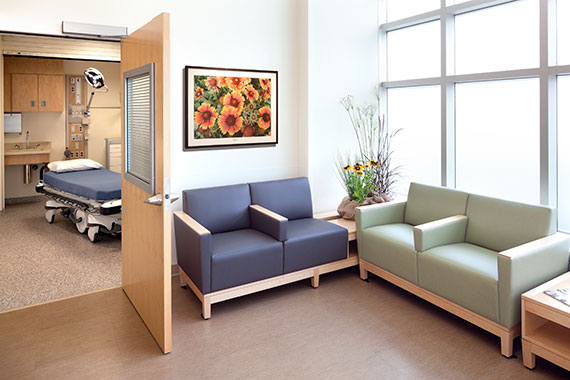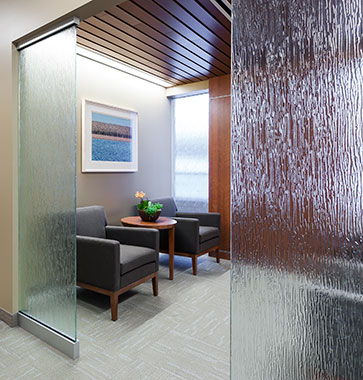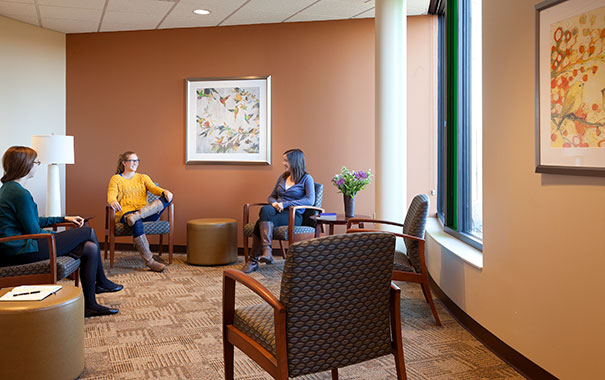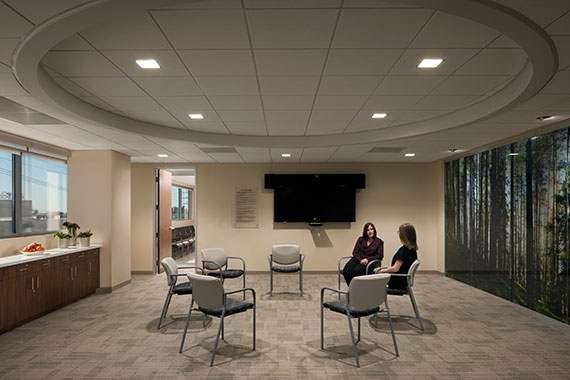6 Behavioral Health Design Trends
HGA has designed behavioral health facilities across the country—including several mental health units within hospitals and numerous addiction treatment facilities—and has identified six approaches that not only help reduce the stigma associated with mental health issues but also fully address the needs of patients’ physical and mental well-being. Consideration of these trends in healthcare planning and design can positively impact costs, functional capabilities, and safety for patients and staff.
1. Quick patient assessment
While our culture generally accepts the notion that it’s necessary to go see a doctor if one isn’t feeling well physically, it isn’t as accepted for one to see a professional if not feeling well mentally. Therefore, those suffering from mental health disorders often aren’t identified or treated in an appropriate and timely manner and may end up in the hospital emergency department in a state of crisis.
Unless emergency departments have the right professionals prepared to address these specific crises and assess patients’ mental health needs, the experience in emergency may do them more harm than good.
Built environment solutions that support this process include the creation of calming assessment areas where mental health professionals can meet with patients in more of a clinic setting that features lounge-type settings and consultation rooms. There will always be a need for seclusion spaces, but not every patient in crisis should be in that environment.
2. Integrated care
A major trend in general medicine today is including designated care coordinators for behavioral health patients. Whether in a primary care, wellness, or preventive care clinic, the care coordinators meet with behavioral health patients to ensure the availability and correct dosage of medications, discuss mental health issues, and evaluate behavioral health concerns. Care coordinators bridge patients’ physical and mental healthcare by providing a whole-person approach to patient care in one setting.
Supporting this trend means not only providing work space for these individuals but more consultation rooms integrated within clinics. The typical exam room isn’t necessarily appropriate for the conversations patients have with these health professionals.
3. Telemedicine
Because there’s a shortage of mental health professionals, especially in rural areas, healthcare systems are incorporating virtual or online treatment approaches into primary care settings. While dedicated rooms for telemedicine can be created—including designated quiet offices with the appropriate lighting and technology—anyone with a screen, from a laptop to a handheld device, can consult with a professional using this technology. However, it’s important to provide acoustical privacy.
4. Inpatient beds
Many health systems are recognizing a shortage of behavioral health inpatient beds and looking for ways to cost effectively add units. One way this is occurring is by converting old medical/surgical units to behavioral health units. The Facility Guidelines Institute and American Institute of Architects both provide guidelines for the design of psychiatric hospitals and therapeutic environments, which stress design and planning that maximize openness and provide access to natural light and the outdoors. At the same time, the guidelines stress planning for staff and patient safety through the design of rooms with various levels of security and supervision.
These spaces are very different from typical med/surg units, and these conversions require more than upgrading finishes to include anti-ligature hardware. For example, the number of beds on these units will be reduced as space for community and treatment will need to be added. The nurses’ station and support rooms should be located centrally for visibility of patients but also need to be secured from patients.
Also, when building inpatient units, it will be important to understand the types of patients and if populations will need to be segregated due to age and gender.
5. Strengthened outpatient services
While providers are answering the shortage of inpatient beds, outpatient services are also becoming stronger and more efficient—a trend that will likely lead to a reduced need for inpatient beds as more care is delivered in these settings. Healthcare systems are working toward this end in several ways. For example, intensive day programs for people struggling with addiction or depression allow patients to return home in the evenings where they can be with family in a comfortable and familiar environment. Also, by combining behavioral health services within primary care settings, the need for patients to travel is reduced.
These outpatient settings should feel like community centers that welcome patients on a regular basis. They might have planned and impromptu gathering places for peer support to take place and quiet meditative rooms that allow for personal reflection.
6. Specialty programs
Behavioral health is no longer one-size-fits-all. Researchers and practitioners are realizing different populations—including children and adolescents, mothers, professionals, or LGBTQ patients—require different treatment approaches. While designing for these populations, commonalities exist such as the standards of plentiful daylight and security and safety for staff and patients.
However, social spaces, separate units for men and women, and sometimes shared rooms—as opposed to private rooms in physical or medical care—may lead to better outcomes. Some substance abuse treatment facilities have a mix of shared and single rooms because some patients provide accountability and peer support in a shared environment that isn’t provided in a private room.
Rebecca Kleinbaum Sanders, AIA, NCARB, is a principal that specializes in healthcare architecture, medical planning, and programming at HGA Architects and Engineers (Minneapolis). She can be reached at RSanders@HGA.com.






